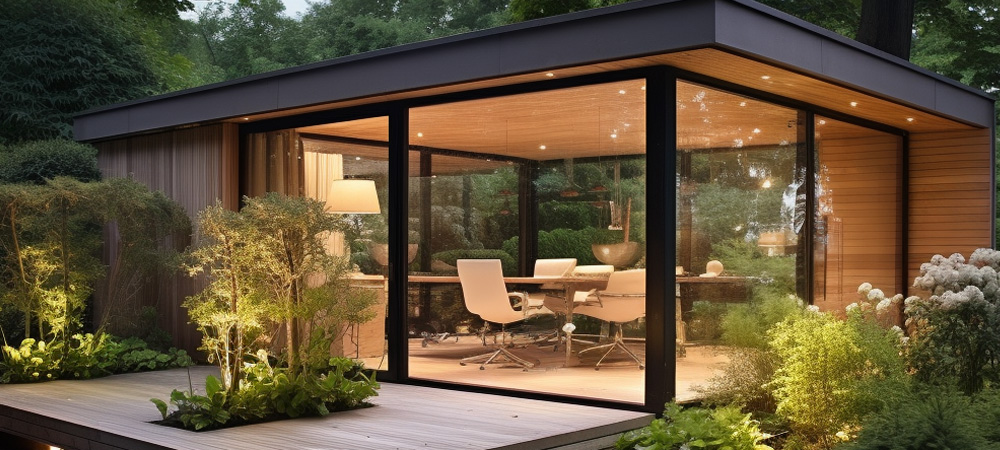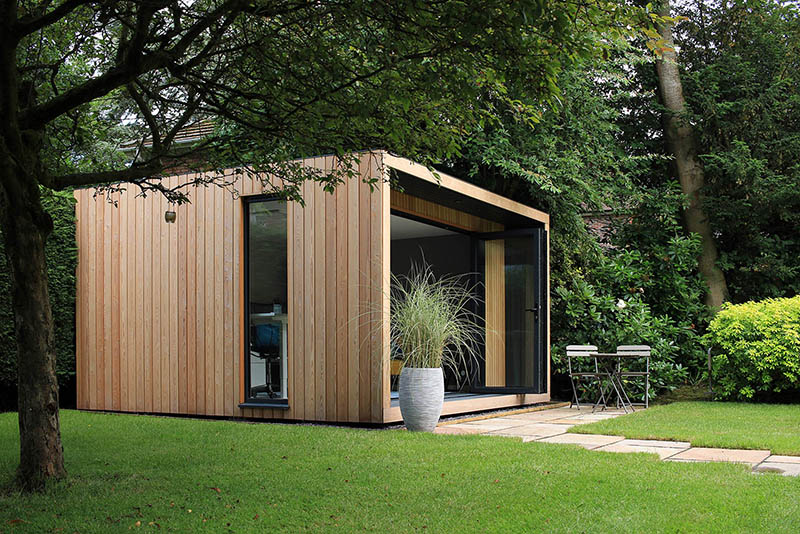What Planning Permits Are Required For Garden Rooms As Well As Other Structures?
Size restrictions on specific areas will usually determine whether planning permission is needed for extensions to garden rooms, extension or conservatories with outhouses. Here's a list of the most common dimensions that may make you need permission to plan.
Planning permission is required for any detached outbuilding in excess of 50 percent of the total that surrounds the home (excluding its footprint).
Height Restrictions
Single-story structures. The eaves' maximum height can't be more than 2.5 meters.
The building is located within 2 metres of the boundary of the property: Maximum Height is 2.5 meters.
Floor Area:
Floors that are that exceeds 30 square metres could need building regulations approval even when planning permission isn't required.
The closeness of boundaries:
Planning permission is typically required for buildings that are within 2 metres of a property boundary.
Building Use
Although it is not a strict limitation on size, the planned usage of the garden room will determine the need for planning permission. Planning permission might be needed in the event that, for example the structure is planned to be used as a residential or business space.
Permitted Development Rights:
Permitted Development Rights (which allows for certain types of work to be completed without the need for full planning applications) have specific size limitations and terms. These rights vary depending on the location of the property an area of conservation or is subject to other restrictions.
Conservatories or Extensions
In general, for a single-story extension at the rear of a detached home, maximum depth is 4 meters and for semi-detached or terraced houses, it's 3 meters. They can be raised to 8 meters or 6 meters under the Neighbourly Consulting Scheme if certain conditions are met.
The rear extension of an uni-story home can't be higher than 4 metres.
Side Extenders
The maximum height for an extension sideways should not be more than 4 meters.
Volume Restrictions
In some areas, like conservation zones or Areas of Outstanding Natural Beauty Any construction which is greater than 10% or expands its volume by 50 cubic meters may require planning consent.
Front Extensions:
Planning permission is normally required for extensions which extend beyond the original house's frontage that faces the road.
It is important to check with the local authorities, as regulations can vary depending the location you reside in and what conditions are present at the property. It is important to inquire with your local planning authority, because rules can differ based on the council's policies and properties' conditions. See the recommended garden electric cable for blog recommendations including outhouses, garden office hertfordshire, gym outhouse, out house, garden buildings , gym outhouse, garden room planning permission, costco garden room, garden rooms near me, outhouse buildings and more.
.jpg)
What Planning Permission Is Required For Gardens, Rooms, Etc. In Relation To Neighbourhood Concerns?
If you're planning to build conservatories, garden offices outhouses, garden offices or outhouses the issues of your neighbors will decide whether planning permission is needed. Two important considerations: Overlooking and privacy:
Planning permission is necessary if the construction could result in privacy being diminished by obstructing neighboring homes. The new structure should not negatively affect the surrounding residents' living conditions.
Light loss and shadowing
If the proposed building is likely to overshadow or cause a significant loss in light for neighboring properties, planning permission may be required. The local planning authority will be able to determine the impact of the proposed building on sunlight and daylight in nearby properties.
Noise and Disturbance
Planning permission is needed when the space will be used to generate noise, such as for a home office where clients can come in an office, workshop or music room. It will ensure that the noise level will be acceptable and won't affect the surroundings.
Visual Impact:
The design, size and style of the new structure should be in line with the aesthetics of the neighborhood. Planning permission ensures that the proposed development does not interfere with the aesthetics and is acceptable visually.
Boundary proximity:
Constructions that are built near the boundary of a property may require permission for planning, particularly if they are higher than 2.5 meters within 2 meters of the boundary. The reason for this is to deal with potential conflicts and the impact they could have on neighbors' properties.
Shared Access Rights of Way and Rights of Way
To ensure that the rights of access shared by all of way are not obstructed or adversely affected by the construction planning permission is required.
Rejections From Neighbors
Residents in the immediate vicinity have the right to speak with neighbors regarding planning applications. Planning authorities will take into account the concerns of neighbors in deciding whether to approve the application.
Effect on the value of property
While not always a primary consideration, significant changes that could affect the value of homes in the vicinity may affect the necessity for planning permission. The local authority will weigh the impact of these changes when making a decision.
Covenants and Deed Restrictions
There could be covenants, deed limitations or other legal agreements on the property. These could have to be followed regardless of planning permission. Legal agreements can dictate what is and is not permitted to be built. This could affect neighborhood harmony.
Construction Disturbance:
Planning permission may be granted in order to resolve concerns about disturbances caused during construction such as dust, traffic and noise. To limit the effects of construction on neighbors, the conditions can be imposed.
Infrastructure Impact:
If the construction puts more strain on infrastructure in the area (e.g. drainage, parking, road usage), planning permission ensures that these effects are evaluated and addressed accordingly.
Community Consultation:
In some instances there may be a need to seek out a larger community especially when it comes to large or controversial projects. This allows for a more democratic decision-making process, taking into account the views of the local community.
Summary The neighborhood concerns are an important factor in the approval process of garden rooms, conservatories or outhouses. The proposed development should not negatively affect the living conditions of neighbors and their privacy, the quality of light and sound as well as the overall look and feel. Early discussions with local authorities and interactions with neighbors can solve these issues. This will allow for the approval process. See the top luxury garden building for website recommendations including garden room permitted development, best electric heater for cabin, garden room planning permission, garden room planning permission, costco outbuildings, what is a garden room, what is a garden room, garden room vs extension, garden rooms near me, my outhouse and more.

What Kind Of Planning Permission Do You Need For Garden Rooms Or Other Areas.?
If you're contemplating building a conservatory, garden room, outhouses (garden offices), or an extension, utility and infrastructure considerations are essential. This can impact the need for a planning permit. Here are the main factors to consider. Water supply and drainage
If the building being constructed requires connection to water supply or drainage systems, a planning approval might be needed. The water authority in the area might have to evaluate the impact on local water supply and sewer systems.
Gas and Electricity Connections:
If you are planning to connect a building to a gas or electricity supply, you might need an approval for planning. It is vital that the connections are in compliance with all safety standards and construction regulations.
Utility Easements
Planning approval is required for structures which are situated within easements (areas designated to accommodate utility lines and infrastructure). Construction in these areas may require approval from the local utility provider.
Sewage systems and septic tanks
If the new structure is going to require a septic system, or an on-site treatment system for sewage, planning permission will be required. This system should be in line with the health and environmental regulations.
Drainage and Surface Water Management
You might need planning permission for drainage and surface water runoff. It might be required to adopt measures to stop erosion, flooding and water pollution.
Access to Utilities for Construction
The planning permission may be needed in order to allow temporary access to utilities like water for construction. Connections that are temporary must be in compliance with safety and environment standards.
Local Impact on Infrastructure:
To assess the impact on local infrastructure such as utilities, roads and public services, etc. It is required to obtain a planning permit. The local authority will assess the infrastructure that is in place and whether it will be used to support the expansion.
Waste Management and recycling:
Planning permission may require requirements for recycling and waste disposal during or after construction. Proper provisions for waste disposal and recycling should be put implemented to minimize environmental impact.
Energy Efficiency as well as Renewable Energy
It is possible that you require permission for the installation of renewable energy systems like solar panels or heat pumps in new structures. It is crucial to be in compliance with building and environmental standards.
Telecommunications (and Internet):
Planning permission is required for new structures that require Internet or telecommunications connections. The infrastructure must comply with all standards and regulations.
Access to roads and footpaths
Making or altering access roads and pedestrian paths to a new construction site may require planning permission. The construction of roads and footpaths must conform to the highest safety standards.
Public Transport Accessibility
A planning permit may be needed if the new construction affects transportation facilities for public use for example, bus stops and train stations. To ensure that public transportation infrastructure meets standards and regulations, it is vital that the building comply with these standards.
In short, utilities and infrastructure aspects are essential in determining whether or not a planning permit is required for extensions, garden rooms, outhouses, or garden offices. It is essential to consult with the planning department early to ensure that the building is in compliance with all applicable standards and regulations. Take a look at the recommended cedar garden room birmingham for site info including garden room conservatory, garden rooms near me, best electric heater for cabin, how to get power to a garden room, garden room permitted development, best electric heater for cabin, garden room permitted development, best electric heater for cabin, garden room planning permission, herts garden rooms and more.

Comments on “Good Tips For Planning Permission For Garden Extension”